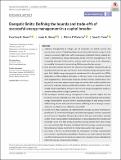Files in this item
Energetic limits : defining the bounds and trade-offs of successful energy management in a capital breeder
Item metadata
| dc.contributor.author | Schuert, Courtney | |
| dc.contributor.author | Halsey, Lewis | |
| dc.contributor.author | Pomeroy, Patrick | |
| dc.contributor.author | Twiss, Sean | |
| dc.date.accessioned | 2020-09-22T09:30:01Z | |
| dc.date.available | 2020-09-22T09:30:01Z | |
| dc.date.issued | 2020-09-07 | |
| dc.identifier | 258343767 | |
| dc.identifier | 861ccf9e-f49f-46e7-bfff-389cf77b4f21 | |
| dc.identifier | 000566668800001 | |
| dc.identifier | 85090308520 | |
| dc.identifier.citation | Schuert , C , Halsey , L , Pomeroy , P & Twiss , S 2020 , ' Energetic limits : defining the bounds and trade-offs of successful energy management in a capital breeder ' , Journal of Animal Ecology , vol. Early View . https://doi.org/10.1111/1365-2656.13312 | en |
| dc.identifier.issn | 0021-8790 | |
| dc.identifier.other | ORCID: /0000-0003-1603-5630/work/80257346 | |
| dc.identifier.uri | https://hdl.handle.net/10023/20662 | |
| dc.description | Funding for this research was provided by the Durham Doctoral Studentship (awarded to C.R.S.) and supported by core funding to the Sea Mammal Research Unit at the University of St. Andrews from the Natural Environment Research Council (NE/RO15007/1 and NE/M01357X/1). | en |
| dc.description.abstract | Judicious management of energy can be invaluable for animal survival and reproductive success. Capital breeding mammals typically transfer energy to their young at extremely high rates while undergoing prolonged fasting, making lactation a tremendously energy demanding period. Effective management of the competing demands of the mother's energy needs and those of her offspring is presumably fundamental to maximizing lifetime reproductive success.How does the mother maximize her chances of successfully rearing her pup, by ensuring that both her pup and herself have sufficient energy during this ‘energetic fast’? While energy management models were first discussed in the 1990s, application of this analytical technique is still very much in its infancy. Recent work suggests that a broad range of species exhibits ‘energy compensation’; during periods when they expend more energy on activity, their bodies partially compensate by reducing background (basal) metabolic rate as an adaptation to limit overall energy expenditure. However, the value of energy management models in understanding animal ecology is presently unclear.We investigate whether energy management models provide insights into the breeding strategy of phocid seals. Not only do we expect lactating seals to display energy compensation because of their breeding strategy of high energy transfer while fasting, but we anticipate that mothers exhibiting a lack of energy compensation are less likely to rear offspring successfully.On the Isle of May in Scotland, we collected heart rate data as a proxy for energy expenditure in 52 known individual grey seal (Halichoerus grypus) mothers, repeatedly across 3 years of breeding. We provide evidence that grey seal mothers typically exhibit energy compensation during lactation by downregulating their background metabolic rate to limit daily energy expenditure during periods when other energy costs are relatively high. However, individuals that fail to energy compensate during the lactation period are more likely to end lactation earlier than expected. Our study is the first to demonstrate the importance of energy compensation to an animal's reproductive expenditure. Moreover, our multi‐seasonal data indicate that environmental stressors may reduce the capacity of some individuals to follow the energy compensation strategy. | |
| dc.format.extent | 12 | |
| dc.format.extent | 1345633 | |
| dc.language.iso | eng | |
| dc.relation.ispartof | Journal of Animal Ecology | en |
| dc.subject | Capital breeding | en |
| dc.subject | Energy management | en |
| dc.subject | Grey seal | en |
| dc.subject | Lactation | en |
| dc.subject | Reproductive success | en |
| dc.subject | QH301 Biology | en |
| dc.subject | DAS | en |
| dc.subject.lcc | QH301 | en |
| dc.title | Energetic limits : defining the bounds and trade-offs of successful energy management in a capital breeder | en |
| dc.type | Journal article | en |
| dc.contributor.sponsor | NERC | en |
| dc.contributor.institution | University of St Andrews. School of Biology | en |
| dc.contributor.institution | University of St Andrews. Sea Mammal Research Unit | en |
| dc.contributor.institution | University of St Andrews. Marine Alliance for Science & Technology Scotland | en |
| dc.contributor.institution | University of St Andrews. Scottish Oceans Institute | en |
| dc.contributor.institution | University of St Andrews. Centre for Research into Ecological & Environmental Modelling | en |
| dc.identifier.doi | 10.1111/1365-2656.13312 | |
| dc.description.status | Peer reviewed | en |
| dc.identifier.grantnumber | NE/M01357X/1 | en |
This item appears in the following Collection(s)
Items in the St Andrews Research Repository are protected by copyright, with all rights reserved, unless otherwise indicated.

